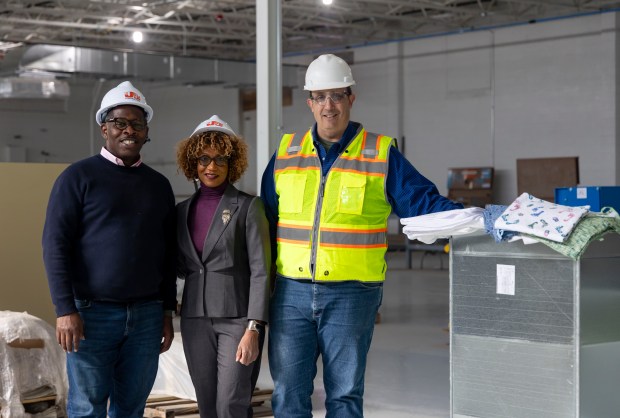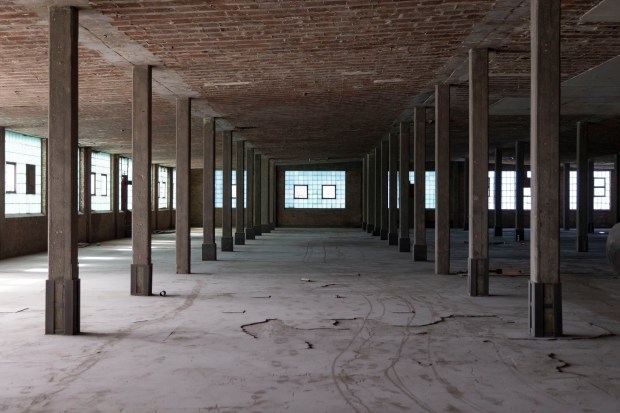A nearly vacant five-story brick building on the West Side will come back to life this summer as The Fillmore Center, eventually employing hundreds and bringing business activity back to North Lawndale, a neighborhood hit by decades of disinvestment.
Steans Family Foundation, a Chicago philanthropy, bought the 111-year-old property at 4100 W. Fillmore St. for $3.3 million in 2022, and construction crews are transforming portions of its cavernous interior into Fillmore Linen Service, an industrial-scale laundry that will serve Chicago hospitals.
The city’s Community Development Commission recommended Tuesday that City Council greenlight a redevelopment agreement between the foundation, its neighborhood partners and the city.
The move will eventually unlock up to $10 million in tax increment financing assistance, said Patricia Ford, the foundation’s executive director, helping complete the $40 million project and bring in more business.
“North Lawndale is a business desert, so business attraction has always been one of our goals,” she said. “We want to make sure we’re reducing North Lawndale’s unemployment rate.”
The foundation will also use tax credits and other grants, including $1.25 million from the Chicago Community Trust’s We Rise Together program, to finance the reconstruction.
Ford envisions the 168,000-square-foot building, originally built for the Calumet Baking Powder Co., providing up to 300 jobs through the laundry and several minority-owned businesses, including Kribi Coffee Air Roastery and Southside Blooms, a flower wholesaler.
But when its boilers, tunnel washers and dryers start up, Fillmore Linen Service will be the heart of the neighborhood’s new economic engine, occupying about 45,000 square feet, providing up to 175 jobs and handling hospital laundry currently sent to out-of-state cleaners.
“We were surprised the majority of this business was shipped out to Wisconsin and Indiana,” Ford said.
The Fillmore Center will be one of the largest job creation projects North Lawndale has seen in years, said Jesse Green, executive director of North Lawndale Community Coordinating Council, a partner on the redevelopment.
“This offers residents the opportunity to earn a living wage, which we know can transform families,” he said. “This will serve as a beacon of hope.”
North Lawndale was once home to Sears’ national mail order operation, which employed thousands at a vast complex just east of The Fillmore Center. But the retailer headed downtown in the 1970s, and local manufacturing giants such as International Harvester and Western Electric also left. Unemployment soared in the following decades, and many residents fled. Small retailers then shut their doors, leaving behind a neighborhood with thousands of vacant lots and little economic activity.
The unemployment rate for North Lawndale was estimated at 18.1% over the five-year period from 2017-2021, according to the Chicago Metropolitan Agency for Planning, which cited data from the Census Bureau’s American Community Survey.
The foundation, which focuses on creating jobs, schools and other educational opportunities in both North Lawndale and the north suburban town of North Chicago, and its partners wanted Fillmore Linen Service up and running in the mostly abandoned building by this summer, said James Kastenholz, CEO of Kastenholz Construction Services and a foundation trustee.
“We said, ‘OK, we have a lot of work to do,’” he said.

They replaced the antiquated mechanical, lighting and plumbing systems, and will also replace its old windows and prepare the upper floors for other tenants, he added.
A city planning report submitted to the Community Development Commission stated it’s likely the foundation won’t need the entire $10 million in TIF funds because the building should generate healthy rental income.
The foundation did not want dead-end jobs, Kastenholz said. The linen service will hire residents from North Lawndale and other West Side neighborhoods, pay between $16 and $18 an hour, and eventually establish a profit-sharing plan.
“This is designed not just to elevate one company, but the people as well,” Green said.
A 2022 report from the Great Cities Institute at the University of Illinois Chicago found North Lawndale’s 35,000 residents spend $124 million of their wages outside the community each year, and although local businesses created about 3,000 jobs between 2010 and 2018, most went to nonresidents.
If all goes well, the foundation will after seven years create a community-run group that will assume ownership of The Fillmore Center, ensuring the building’s profits stay in North Lawndale.
“The community will inherit a building that is fully renovated and filled with businesses that are paying rent,” Ford told the Community Development Commission.
The strategy won praise from commission Chair Gwendolyn Hatten Butler.
“This is quite innovative,” she said.
Other developers have also hatched big plans for North Lawndale.

A joint venture of GRE Ventures, Imagine Group and 548 Development were selected by city officials in 2021 to replace a vacant lot at 3400 W. Ogden Ave. with Lawndale Redefined, a $31.4 million collection of apartments, retail and restaurant spaces, as well as a community center.
In 2022 the city selected 548 Development and Related Midwest to develop at 4300 W. Roosevelt Road the $38.4 million Lawndale Innovation Center, a collection of solar-powered industrial buildings and community centers. The vacant 20-acre site was once an illegal dumping ground made infamous in the 1990s by the federal Operation Silver Shovel investigation, which led to the convictions of several aldermen.
24th Ward Ald. Monique Scott supports the foundation’s Fillmore Center plans.
“North Lawndale is a community on the rise with a thriving economy and boundless potential,” she said in a prepared statement. “Investments from dedicated local groups, alongside partners like the Steans Family Foundation, are how this community can become everything it can.”
Craig Forgea, chief operating officer of Fillmore Linen Service, said one laundry may not be enough.
“We’d eventually like to have a second plant going,” he said.





